Garages often become catch-all spaces, quickly cluttered with everything from tools to sports equipment. Bikes, with their bulky frames, can take up valuable floor space, making your garage feel cramped and disorganized. Reclaiming your garage space starts with utilizing vertical storage, and hanging your bikes is a game-changer. This guide will explore effective methods for how to hang bikes in your garage, freeing up floor space and creating a more organized and functional area.
Why Hang Bikes in Your Garage?
Before diving into the “how-to,” let’s consider the “why.” Hanging your bikes in the garage offers numerous benefits that go beyond just tidiness:
- Maximize Space: Garages are notorious for becoming cluttered. Hanging bikes instantly frees up floor space, making room for cars, tools, or other storage. Vertical bike storage is key to efficient garage organization.
- Protect Your Bikes: Storing bikes on the floor can lead to scratches, dents, and damage from accidental bumps or falling items. Hanging them keeps them safe and secure, prolonging their lifespan and maintaining their condition.
- Easy Access: No more tripping over bikes or struggling to maneuver around them. Hanging bikes makes them easily accessible when you’re ready for a ride and just as easy to store away afterward.
- Improved Garage Aesthetics: A garage with bikes neatly hung on the wall looks cleaner, more organized, and less chaotic than one with bikes strewn across the floor.
- Kid-Friendly Organization (Mostly for Adults Bikes): While hanging kids’ bikes might be challenging for them to manage independently, hanging adult bikes sets a good example and keeps valuable bikes off the floor. For kids bikes, designated floor spots or accessible racks can complement the adult bike hanging system.
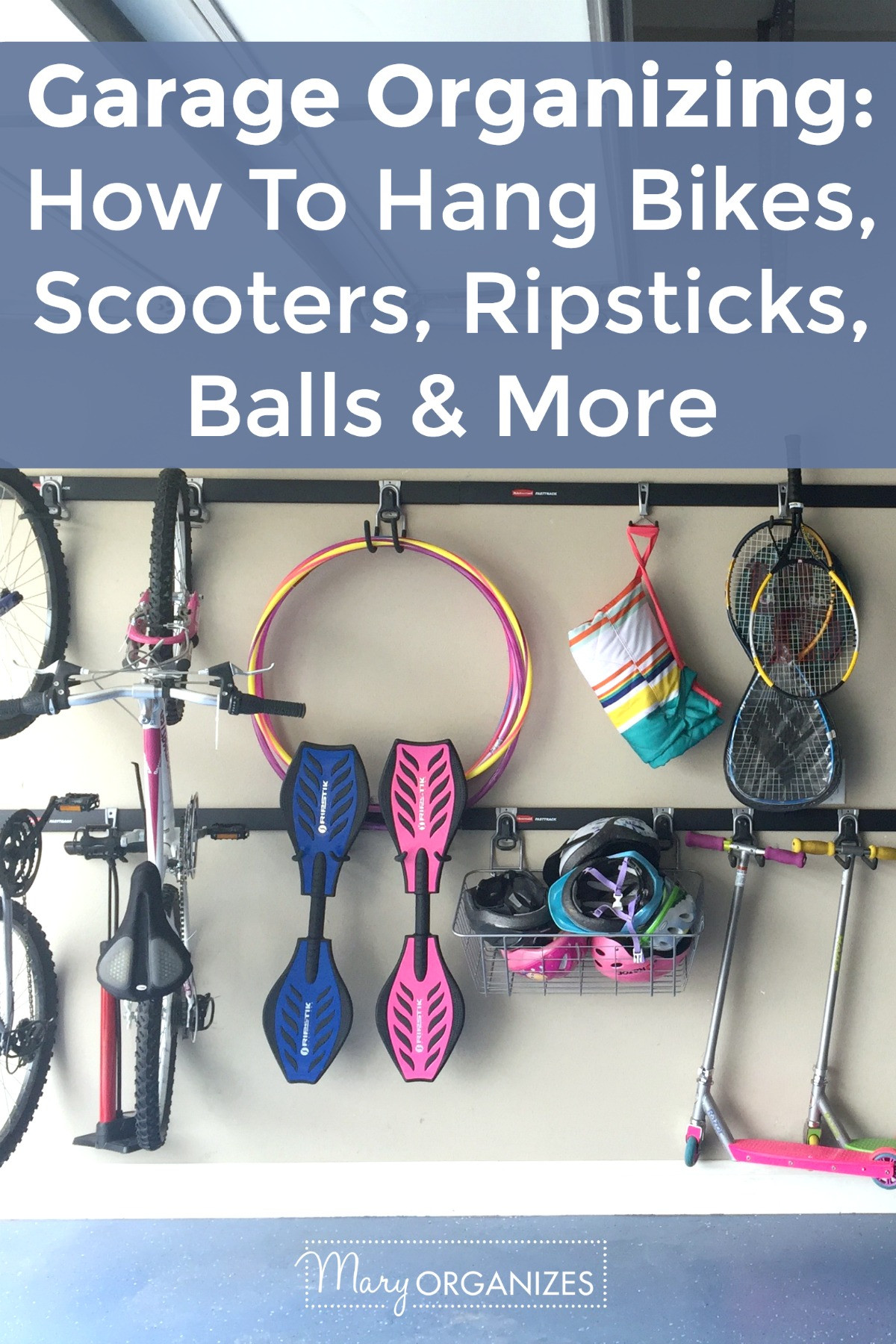 Garage with bikes, scooters, ripsticks, balls and more hung on the wall using a track system.
Garage with bikes, scooters, ripsticks, balls and more hung on the wall using a track system.
Types of Bike Hanging Systems for Your Garage
Choosing the right bike hanging system depends on your garage layout, the types of bikes you own, and your budget. Here are some popular and effective options:
1. Wall-Mounted Bike Hooks
Wall hooks are one of the simplest and most affordable ways to hang bikes in your garage. They typically consist of a coated metal hook that screws directly into the wall studs.
- Pros: Affordable, easy to install, space-saving, suitable for most bike types.
- Cons: Requires lifting the bike to hang, bikes hang parallel to the wall (might stick out), requires finding wall studs for secure installation.
Installation Tip: Ensure you are drilling into wall studs for maximum support. Use a stud finder to locate studs and pre-drill pilot holes before screwing in the hooks.
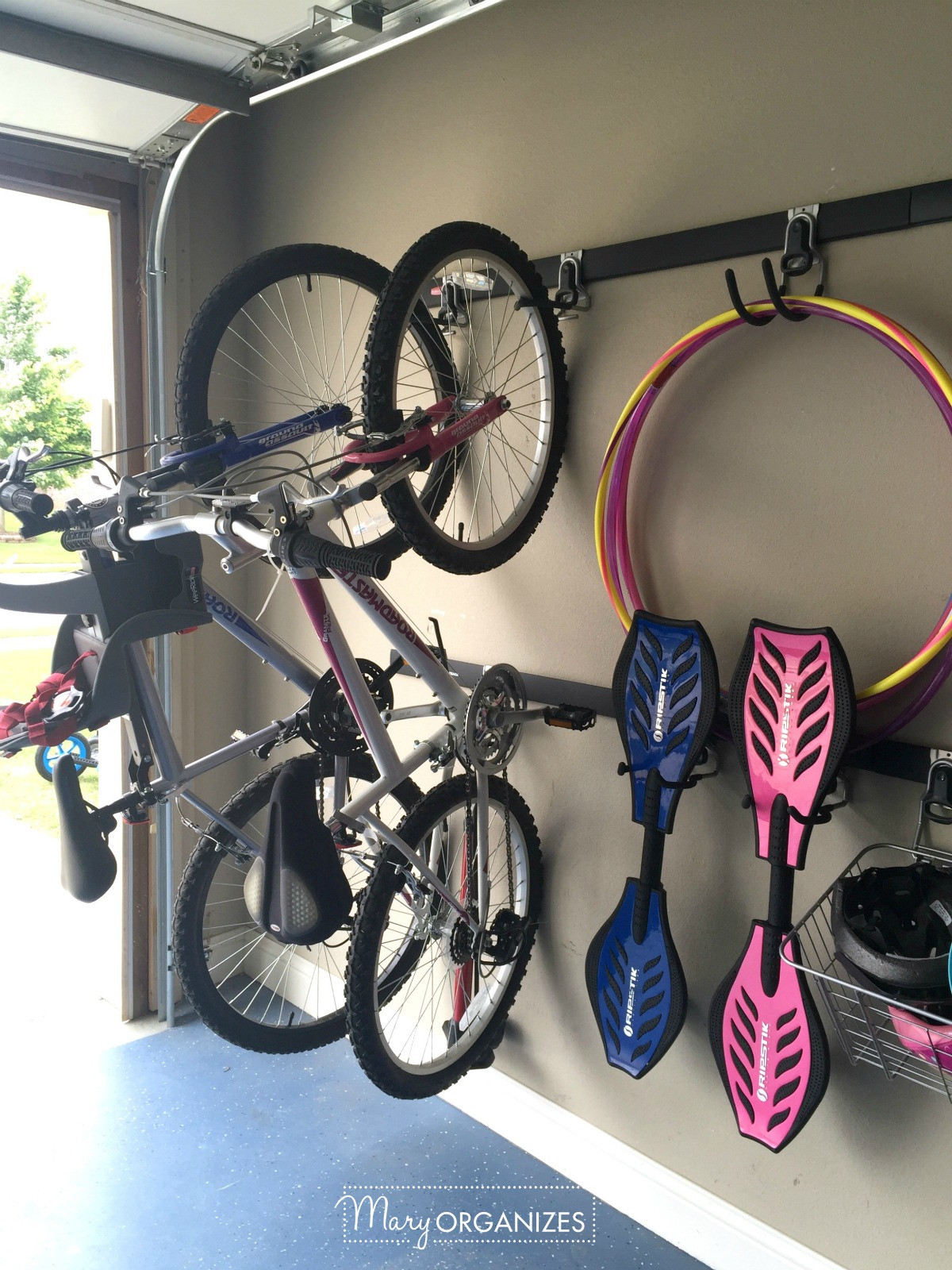 Two adult bikes hanging on wall mounted hooks in a garage, with a bike pump hanging between them.
Two adult bikes hanging on wall mounted hooks in a garage, with a bike pump hanging between them.
2. Ceiling-Mounted Bike Racks
Ceiling bike racks are ideal for garages with high ceilings. They lift bikes up and away, maximizing floor space and keeping bikes completely out of the way.
- Pros: Maximum space saving, keeps bikes completely out of the way, good for long-term storage.
- Cons: Requires higher ceilings, can be more challenging to lift bikes overhead, may require more complex installation, might not be ideal for frequently used bikes.
Installation Tip: Similar to wall hooks, ensure secure mounting to ceiling joists. Some ceiling racks use a pulley system to make lifting bikes easier.
3. Vertical Bike Racks
Vertical bike racks allow you to hang bikes upright, with one or both wheels on the ground. These racks are great for maximizing wall space and can accommodate multiple bikes in a row.
- Pros: Space-efficient for multiple bikes, easy to roll bikes into place, some racks are freestanding and don’t require wall mounting.
- Cons: Bikes still take up some floor space, might require more floor depth than horizontal hanging, some vertical racks can be less stable than other systems.
4. Track and Hook Systems
Track systems, like the Rubbermaid FastTrack system mentioned in the original article, offer versatility and flexibility. A horizontal track is mounted to the wall, and various hooks and accessories can be attached to the track, allowing you to customize your storage.
- Pros: Versatile, adjustable hooks, easy to rearrange storage, can be used for bikes and other garage items.
- Cons: Can be more expensive than simple hooks, requires track installation, hook strength needs to be considered for heavier bikes.
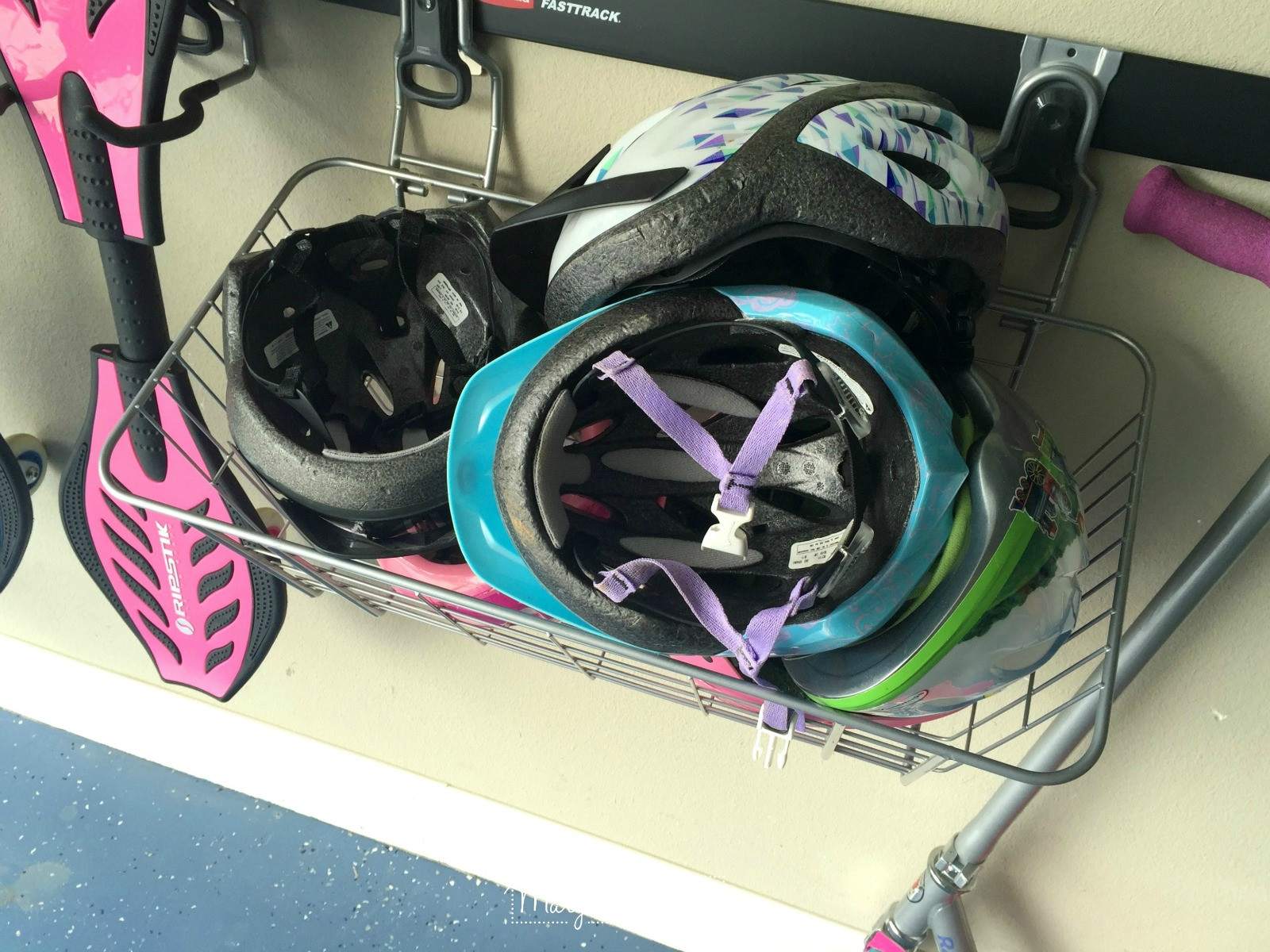 Bike helmets hanging in a basket on a FastTrack system in a garage.
Bike helmets hanging in a basket on a FastTrack system in a garage.
Step-by-Step Guide: How to Hang Bikes with Wall Hooks
Let’s focus on installing wall-mounted bike hooks, a popular and straightforward method for hanging bikes.
What You’ll Need:
- Bike hooks (appropriate for your bike type and weight)
- Stud finder
- Drill
- Drill bits (slightly smaller than the hook screw diameter)
- Pencil
- Measuring tape (optional, for consistent hook spacing)
Steps:
- Locate Wall Studs: Use a stud finder to identify the studs in your garage wall where you want to hang your bikes. Studs are the vertical wooden beams behind the drywall and are necessary for secure mounting.
- Mark Hook Positions: Decide on the height and spacing for your bike hooks. Consider the height of your bikes and how high you can comfortably lift them. If hanging multiple bikes, space the hooks adequately to prevent bikes from bumping into each other. Use a pencil to mark the desired hook locations on the studs.
- Pre-Drill Pilot Holes: Using a drill bit slightly smaller than the screw diameter of your bike hooks, pre-drill pilot holes at your marked locations. Pilot holes make it easier to screw in the hooks straight and prevent wood splitting.
- Install Bike Hooks: Screw the bike hooks into the pre-drilled pilot holes. Ensure they are securely fastened and can support the weight of your bikes.
- Hang Your Bikes: Lift your bike and carefully place the wheel onto the hook. Ensure the bike is stable and securely hung.
Safety First: Always test the hook’s stability before fully releasing your bike. Make sure the hooks are firmly anchored in the studs.
Tips for Efficient and Safe Bike Storage
- Proximity: Keep bike accessories like helmets, pumps, and bike locks near your hung bikes for easy access, as highlighted in the original article. Baskets or hooks on the same track system can be perfect for helmet storage.
- Consider Bike Types: Different bikes may be better suited to different hanging methods. Heavier bikes might require sturdier hooks or ceiling mounts. Consider the frame type and wheel size when choosing hooks.
- Frequency of Use: Hang frequently used bikes in easily accessible locations. Bikes used less often can be stored in higher or less convenient spots.
- Weight Limits: Always check the weight capacity of your chosen hanging system and hooks to ensure they can safely support your bikes.
- Regular Checks: Periodically inspect your bike hanging system to ensure hooks are still securely fastened and show no signs of wear or damage.
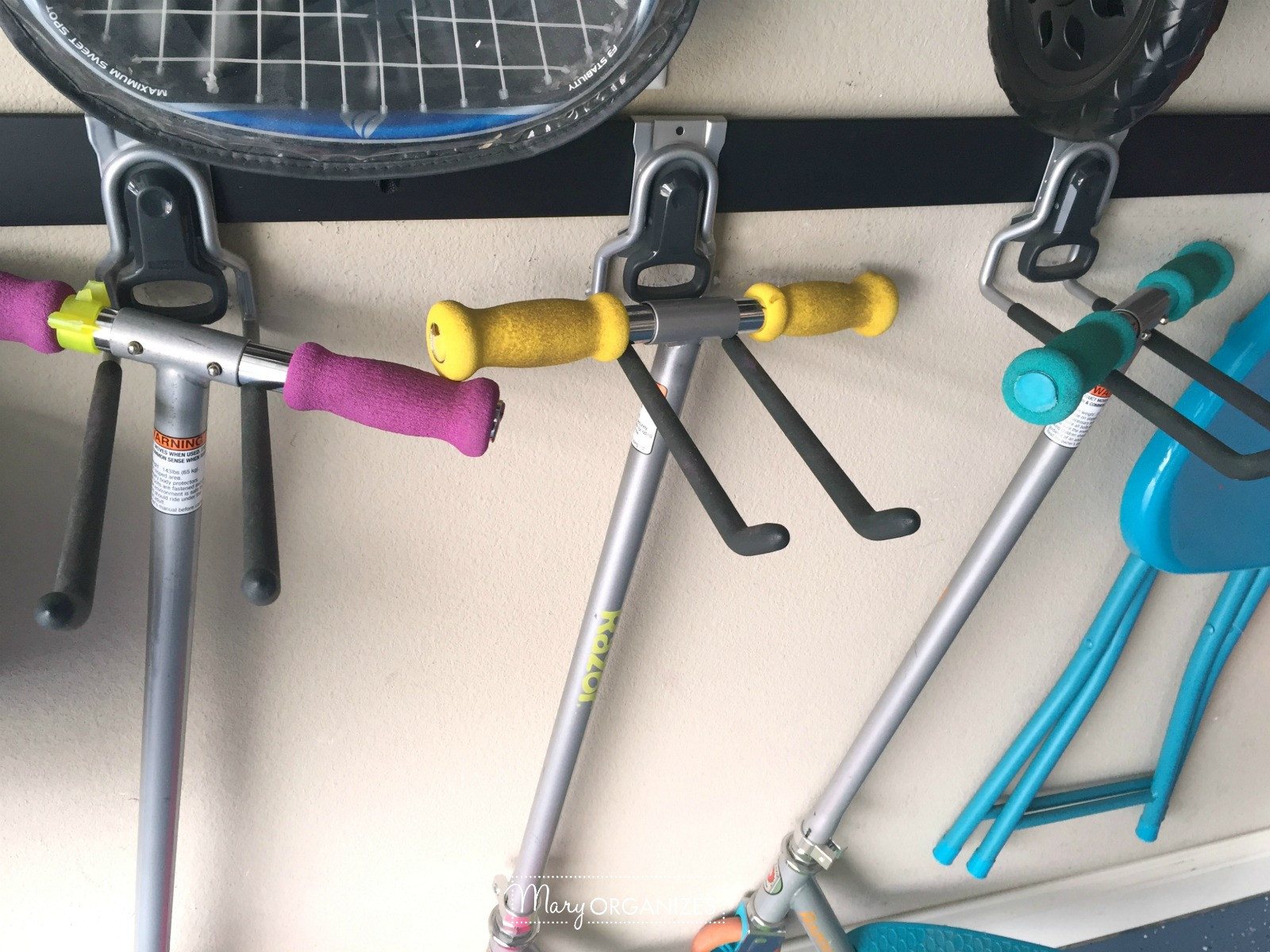 Scooters hanging on multi-purpose hooks in a garage.
Scooters hanging on multi-purpose hooks in a garage.
Beyond Bikes: Expanding Your Garage Organization
Once you’ve tackled bike storage, consider applying the vertical storage principle to other garage items. As the original article demonstrates, track systems and hooks are excellent for organizing scooters, ripsticks, sports balls, and even strollers and tools. Utilizing wall space effectively is the key to a clutter-free and functional garage.
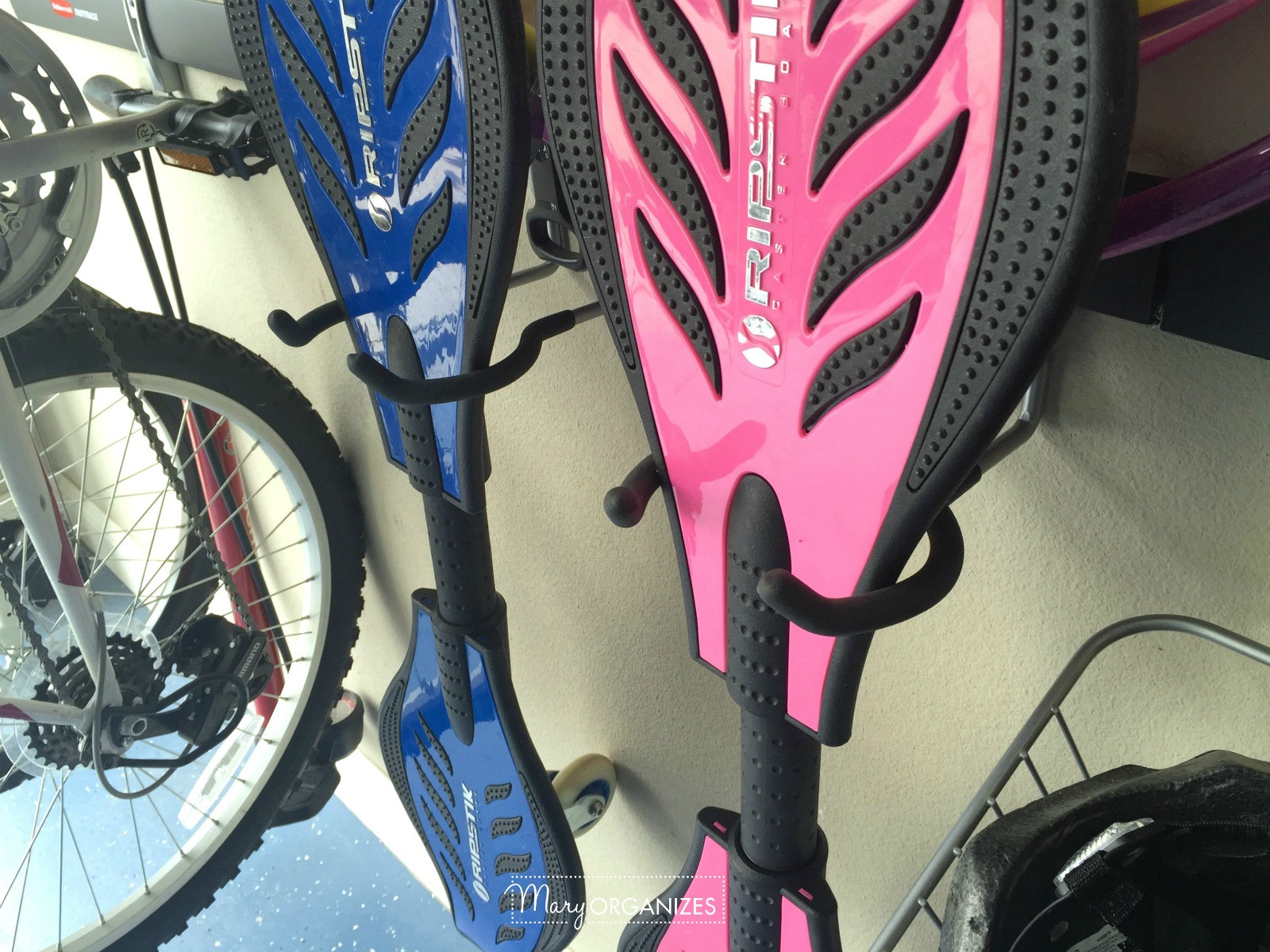 Ripsticks hanging on power tool hooks on a garage wall.
Ripsticks hanging on power tool hooks on a garage wall.
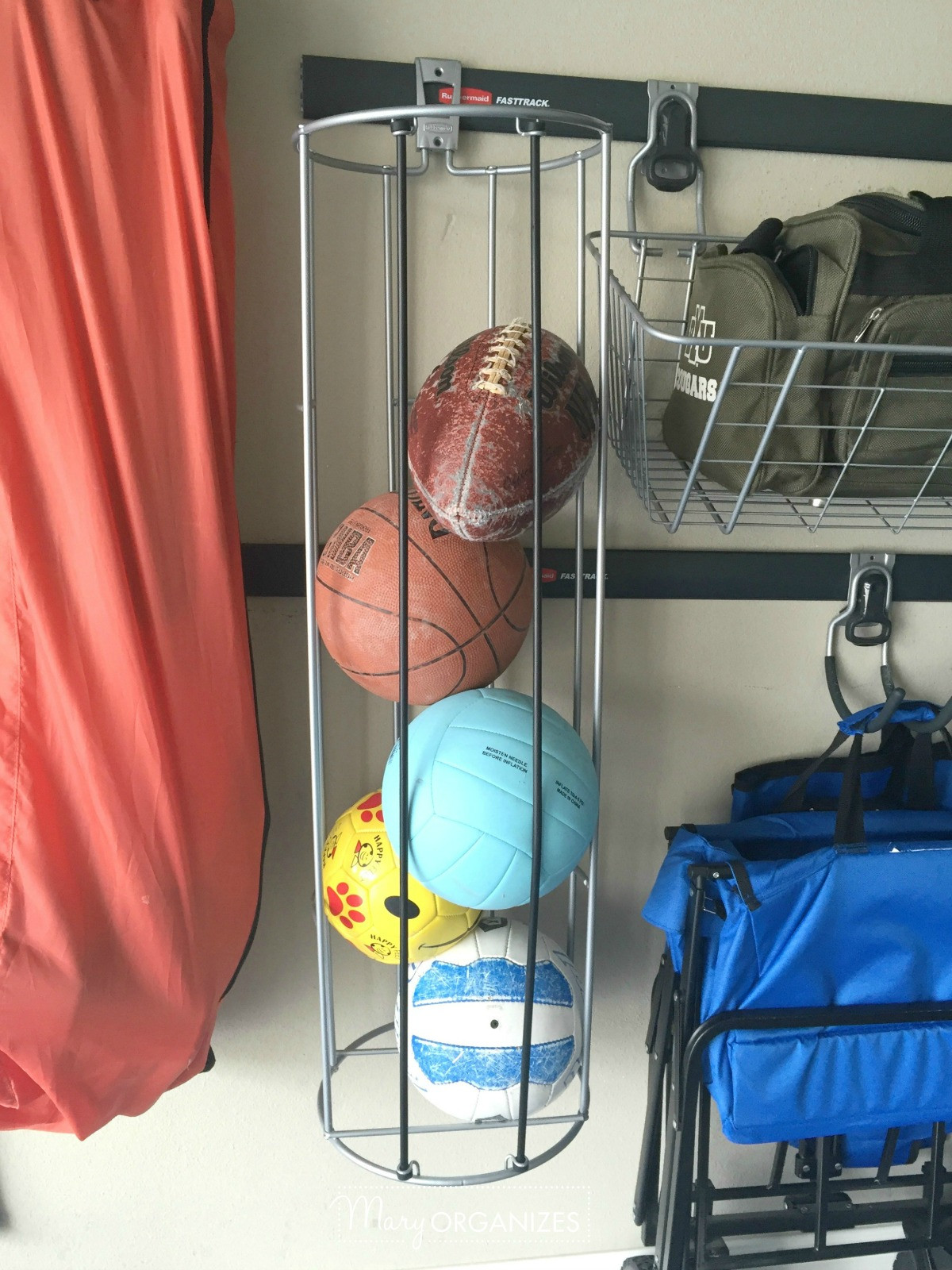 Sports balls organized in a ball organizer in a garage.
Sports balls organized in a ball organizer in a garage.
Reclaim Your Garage Space Today
Hanging bikes in your garage is a simple yet highly effective way to improve organization, maximize space, and protect your valuable equipment. By choosing the right hanging system and following these tips, you can transform your garage into a more functional and enjoyable space. Start hanging your bikes and experience the difference a clutter-free garage can make!
